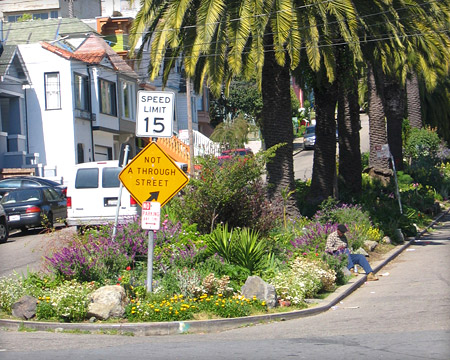See also Greening Overview and Medians and Islands
Many of San Francisco’s medians are designed as hard-paved areas that offer few benefits beyond their traffic-control roles. Adding trees and landscaping to traffic medians can enhance the public realm and improve the aesthetic, traffic calming and ecological functions of the median.
Process Overview
Median greening projects share similarities with sidewalk landscaping, but are more complex because they front on many properties and are located in the center of the roadway. The process will depend on the scale of the project and the role of the street the median sits within.
Median greening projects are typically installed by community groups like neighborhood or merchant’s associations, or as part of a larger package of corridor-wide improvements. These projects are generally not installed by individual property owners, tenants, or business owners.
Median greening projects incorporating stormwater management features require complex engineering and are typically built in coordination with other streetscape and LID features as part of block- or neighborhood-scale projects. See Stormwater Overview.
Build Neighborhood Support
Because median greening projects front on numerous properties, they require community buy-in. The city requires that median greening projects be sponsored or co-sponsored by a community organization such as a neighborhood or merchant’s organization. The first step in a median greening project is to conduct public outreach and build neighborhood support for the project, including neighbors and community groups.
See Building Neighborhood Support
Identify Funding
Previous median greening projects have utilized different revenue sources to fund median greening projects including, grants, community matching funds and city funds. In some instances, residents have raised funds to implement median greening in their neighborhood. A robust community outreach effort will help make the case for your project among potential funders.
Some median greening projects have worked with the Street Parks Program, a partnership between DPW, the San Francisco Parks Alliance and the residents of San Francisco to develop and create community managed gardens on public rights of way owned by DPW.
See Funding and Technical Resources
Acquire Permits
The specific permit issued for median greening projects will vary depending on the project’s scale. Smaller projects will require a Sidewalk Landscaping Permit from DPW. Larger areas involving multiple blocks will require a Major Encroachment Permit from DPW.
See Permit Process
Official Codes & Documents
- Better Streets Plan (street design guidelines)
- Stormwater Design Guidelines
(guidelines for design of low-impact development stormwater management features) - DPW Director’s Order on Street Trees
(standards for street tree planting)
Design Guidelines
If your project involves construction of a new median, see also Medians and Islands
If you are greening an existing median, see also Greening Overview and Street Trees
Tress may be planted in medians 4 feet or wider, including curbs. Trees planted in medians should have arching canopy structures that provide visibility without excessive pruning, or be upright and columnar in form.
Tree species selected for planting on median strips that are 4 to 6 feet wide should be expected to grow to trunk diameters no greater than 12 inches. On median strips greater than 6 feet wide, trees obtaining larger diameters may be used.
Trees with columnar form are appropriate for narrower planting spaces such as small streets, alleys, and narrow medians.
Trees located in medians should have a vertical clearance of the lowest branch of 8 feet in height over the median, and 14 feet in height for any portion of the tree that overhangs the roadway. Shrubs located in the median should not exceed 3.5 feet above the roadway.
Landscaped medians reduce impervious space in the roadway, allowing stormwater infiltration or retention in the exposed soil. Medians can also be designed to retain, cleanse, and infiltrate stormwater runoff from the roadway. Where stormwater management is intended in the median, the street should be graded to drain toward the median.
Maintenance
Because of the safety risks posed by passing traffic, in most cases, DPW may need to assume maintenance responsibility for median greening projects. Ensure that DPW supports and has approved all designs to minimize maintenance needs. In rare cases where streets are calm residential streets, DPW might approve neighborhood maintenance of a median. Contact DPW to discuss options at the very beginning of your project planning.
Community groups sponsoring median greening projects should consider the ongoing maintenance of the project early in the design process and talk with DPW to design for low maintenance projects to ensure long-term success and beauty of the project.
Stormwater treatment facilities incorporated into median greening projects are functioning elements of the stormwater infrastructure and must be maintained to serve their required stormwater function.
If initial or ongoing irrigation is needed, the project should have access to a metered water source and seek approval from the account holder to use the water service. If the meter is a mixed use meter (i.e. also serves a home or business), the landscape project must be under 5,000 square feet. Otherwise, dedicated irrigation meters are required for landscape projects over 5,000 square feet per the Water Efficient Irrigation Ordinance. Contact SFPUC Customer Service to locate water service account information.
For a more detailed description of maintenance responsibilities, see Maintenance.







 Copyright © 2015
Copyright © 2015